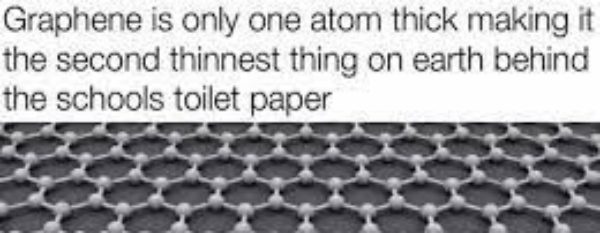Graphene is the new plastic
Not necessarily in the good ways.

The thin, atom-thick sheets of carbon called graphene are the thinnest and simultaneously the strongest material known to science. Graphene was discovered about twenty years ago, but so far had no real-world, large scale application, also because of very high production costs.
This year, however, Graphene may be about to “officially begin its revolution, and electric mobility will be the first sector to be overwhelmed”.
The GAC Group announced mass production of electric vehicles with graphene batteries starting this month, that should allow the chinese Aion V SUV to recharge from 0 to 80% in 8 minutes, with an autonomy of 1000 km.

This means, says Medium, that radical innovation is coming Real Soon Now, to many fields that sorely need it, from super-efficient solar cells to water purification and management of nuclear waste.
So far, so good. Except a couple of things
Graphene batteries would not suffer “the two crucial problems with lithium batteries: a tendency to deform once discharged and poor electricity conduction”.
That’s good, but all electric cars with any kind of batteries as efficient as the Aion V would have the same problem I commented ten days ago: selling them in volumes before heavily restructuring today’s power grids would, to put it really mildly, create problems.
Apart from that, there is an issue totally missing from that ode to graphene (which, to be fair, does discuss the power grid problems): what about graphene as one more potential source of large scale pollution?
Yes, “smog-eating graphene composite reduces atmospheric pollution” (2019). But graphene may also Be Pollutant Of The Future (2014), because “the situation today is similar to where we were with chemicals and pharmaceuticals 30 years ago… We just don’t know much about what happens when these engineered nanomaterials get into the ground or water. So we have to be proactive so we have the data available to promote sustainable applications of this technology in the future."
On the same note, a 2014 paper entitled “Stability and Transport of Graphene Oxide Nanoparticles in Groundwater and Surface Water” found that graphene was a powerful environmental contaminant. Another article on Nature, from 2019, “stresses the need to move from relatively simple laboratory-scale studies to more complex and more realistic conditions, which is becoming a generally recognized necessity for environmental nanotechnology studies."
So, I would conclude with the same recommendation found in “Ideas About Graphene Risks” (2018): “more research into what researchers and innovation advisors should do in practice in order to qualify as responsible” whenever large scale uses of graphene are discussed.
Graphene, yes. Plastic 2.0 NO, thank you very much
Graphene is great, and there are surely lots of necessary and responsible uses for it, but we really don’t need a “Plastic crisis 2.0”. Not now, not in just a few decades. Please ask all the right questions, before investing in graphene, or regulating it.
Image sources: Quickmeme
Who writes this, why, and how to help
I am Marco Fioretti, tech writer and aspiring polymath doing human-digital research and popularization.
I do it because YOUR civil rights and the quality of YOUR life depend every year more on how software is used AROUND you.
To this end, I have already shared more than a million words on this blog, without any paywall or user tracking, and am sharing the next million through a newsletter, also without any paywall.
The more direct support I get, the more I can continue to inform for free parents, teachers, decision makers, and everybody else who should know more stuff like this. You can support me with paid subscriptions to my newsletter, donations via PayPal (mfioretti@nexaima.net) or LiberaPay, or in any of the other ways listed here.THANKS for your support!